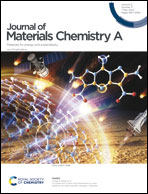Sub-mm3 dimensional scaling of fully-integrated additively-fabricated microsupercapacitors for embedded energy storage applications†
Abstract
Microsupercapacitors (MSCs) are attractive energy devices for applications in IoT, wireless sensors, and other microelectronic systems due to their small footprints. In this work, the dimensional scaling of fully-integrated additively-fabricated MSCs is systematically investigated. The dimensions of the MSCs are scaled by varying the length and cross-section of their electrodes to study their scalability to the mm3 range, making them attractive for even chip-scale embedding. MSCs with the thickest electrodes demonstrate the highest values of capacitance and energy density, while MSCs with the thinnest electrodes show lower capacitance and energy densities, but deliver higher power densities. We observe that as expected, capacitance scales with dimensions. We observe excellent performance levels, including maximum areal capacitance of ∼731.7 mF cm−2, areal energy density of ∼36.59 μW h cm−2, areal power density of ∼2669.8 mW cm−2, and ∼95% capacitance retention after 17 000 cycles. These MSCs also show maximum volumetric capacitance, volumetric energy density, and volumetric power density of 8.7 F cm−3, 0.436 mW h cm−3, and 31.78 W cm−3, respectively. Overall, these are the highest values reported to date for such systems. These results are achieved by utilizing novel chemistries for the components of the MSCs and from tuning their geometry. The electrodes of the MSCs are formed from a nanocomposite of edge-oxidized graphite oxide (EOGO)/cerium oxide nanoparticles to benefit from both electrical double-layer capacitance (EDLC) and pseudocapacitance, the electrolyte is a UV-curable hydrogel based on (poly(ethylene glycol) diacrylate (PEGDA) + LiCl + lithium phenyl-2,4,6-trimethylbenzoylphosphinate (LAP) + water), and the current collector is a silver paste. These MSCs are fully packaged and sealed by 3D printing a package using polycaprolactone (PCL) and depositing a UV-curable resin-based encapsulant. Our findings demonstrate that such devices can be scaled to mm3 volumes while continuing to deliver excellent performance, making them attractive candidates for a range of embedded energy storage applications.



 Please wait while we load your content...
Please wait while we load your content...